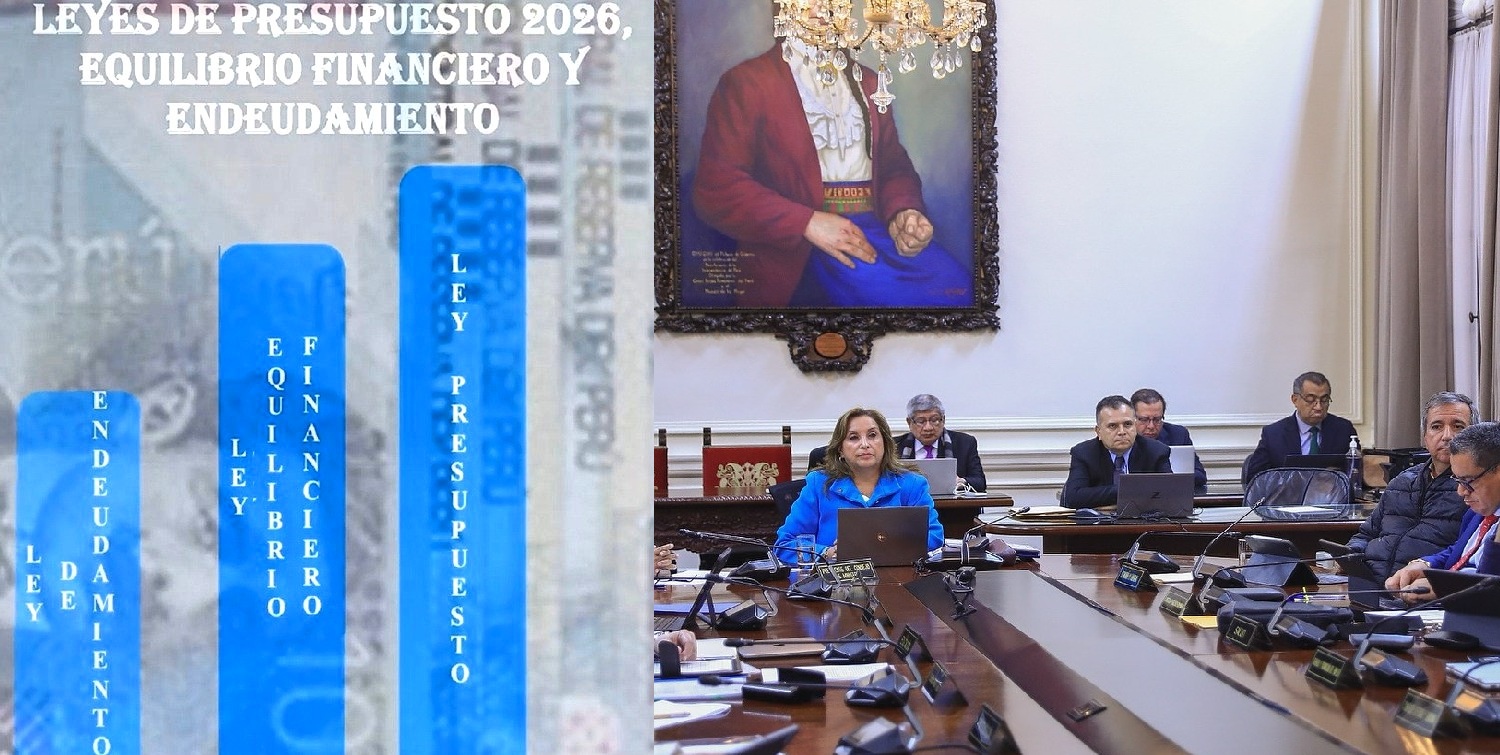Agencia Peruana de Noticias PRENSAPERU.PE https://prensaperu.pe/ Twitter: @prensaperupe En la víspera la Presidencia de la República informó que el Consejo de Ministros aprobó los proyectos de leyes de Presupuesto 2026, Equilibrio Financiero y Endeudamiento; que se resumen en más obras en educación, salud y seguridad para todos los peruanos y para seguir construyendo un Perú mejor.
Del mismo modo se señaló que en una sesión histórica, el Consejo de Ministros aprobó por unanimidad los proyectos de leyes de Presupuesto 2026, de Equilibrio Financiero y de Endeudamiento. Esta decisión marca un hito en la planificación económica del país y sienta las bases para la ejecución de obras cruciales en infraestructura educativa, salud, seguridad ciudadana y otros sectores prioritarios, se señaló.
I.- LEY DE PRESUPUESTO 2026.
La Ley de Presupuesto es una norma legal que establece los ingresos y gastos del Estado para un año fiscal específico. En el caso de Perú, esta ley es crucial porque define cómo se asignarán los recursos públicos a los diferentes sectores del país, como educación, salud, infraestructura, entre otros.
Objetivo Principal.
Asignar los recursos del Estado de manera eficiente y transparente para cumplir con las políticas y metas del gobierno.
COMPONENTES CLAVE.
Ingresos.
Detalla las fuentes de ingresos del Estado, como impuestos, tasas y contribuciones.
Gastos.
Especifica cómo se distribuirán los fondos a los diferentes ministerios y entidades públicas.
Importancia.
Permite la ejecución de proyectos y programas gubernamentales, asegurando el funcionamiento del Estado y la provisión de servicios públicos esenciales.
II.- LEY DE EQUILIBRIO FINANCIERO.
La Ley de Equilibrio Financiero busca asegurar la estabilidad en la ejecución del presupuesto del sector público. Esta ley establece reglas y mecanismos para mantener el balance entre los ingresos y los gastos del Estado, evitando déficits fiscales que puedan comprometer la economía del país.
Objetivo Principal.
Mantener la estabilidad presupuestaria y fiscal durante el año fiscal.
MECANISMOS CLAVE.
Reglas de Estabilidad.
Establece límites y restricciones al gasto público para evitar desequilibrios.
Autorización de Recursos.
Permite el uso de recursos provenientes de operaciones de endeudamiento para financiar el presupuesto.
Importancia.
Contribuye a la sostenibilidad de las finanzas públicas, permitiendo al Estado cumplir con sus obligaciones sin incurrir en deudas excesivas.
III.- LEY DE ENDEUDAMIENTO.
La Ley de Endeudamiento establece los límites y condiciones bajo los cuales el Estado puede contraer deudas. Esta ley es fundamental para regular el endeudamiento público, asegurando que se realice de manera responsable y sostenible, y que los fondos se utilicen en proyectos de inversión que generen beneficios a largo plazo para el país .
Objetivo Principal.
Regular y controlar el endeudamiento del sector público.
ASPECTOS CLAVE.
Límites de Endeudamiento.
Define los montos máximos que el Estado puede endeudarse.
Condiciones de Endeudamiento.
Establece los términos y plazos de los préstamos, así como los proyectos en los que se invertirán los fondos.
Importancia.
Permite al Estado financiar proyectos de inversión y cubrir déficits temporales, pero de manera controlada para evitar el sobreendeudamiento y sus consecuencias negativas.
Fuente: Agencia Peruana de Noticias PRENSAPERU.PE https://prensaperu.pe/ Twitter: @prensaperupe

English Translation
Council of Ministers approves 2026 Budget laws benefiting 35 million Peruvians, which will promote key projects for Peru’s development.
Peruvian News Agency PRENSAPERU.PE https://prensaperu.pe/ Twitter: @prensaperupe Yesterday, the Presidency of the Republic reported that the Council of Ministers approved the 2026 Budget, Financial Balance, and Debt bills. These bills summarize more projects in education, health, and security for all Peruvians and continue building a better Peru.
It was also noted that in a historic session, the Council of Ministers unanimously approved the 2026 Budget, Financial Balance, and Debt bills. This decision marks a milestone in the country’s economic planning and lays the groundwork for the execution of crucial infrastructure projects in education, health, citizen security, and other priority sectors, it was noted.
I.- 2026 BUDGET LAW.
The Budget Law is a legal provision that establishes the state’s revenues and expenditures for a specific fiscal year. In the case of Peru, this law is crucial because it defines how public resources will be allocated to the country’s different sectors, such as education, health, infrastructure, and others.
Main Objective.
To allocate state resources efficiently and transparently to fulfill government policies and goals.
KEY COMPONENTS.
Revenue.
Details the sources of state revenue, such as taxes, fees, and contributions.
Expenditure.
Specifies how funds will be distributed to the various ministries and public entities.
Importance.
Allows for the execution of government projects and programs, ensuring the functioning of the state and the provision of essential public services.
II.- FINANCIAL EQUILIBRIUM LAW.
The Financial Equilibrium Law seeks to ensure stability in the execution of the public sector budget. This law establishes rules and mechanisms to maintain a balance between state revenue and expenditure, avoiding fiscal deficits that could jeopardize the country’s economy.
Main Objective.
Maintain budgetary and fiscal stability during the fiscal year.
KEY MECHANISMS.
Stability Rules.
Establishes limits and restrictions on public spending to avoid imbalances.
Resource Authorization.
Allows the use of resources from borrowing operations to finance the budget.
Importance.
Contributes to the sustainability of public finances, allowing the State to meet its obligations without incurring excessive debt.
III.- DEBT LAW.
The Debt Law establishes the limits and conditions under which the State may incur debt. This law is essential for regulating public borrowing, ensuring that it is carried out responsibly and sustainably, and that the funds are used in investment projects that generate long-term benefits for the country.
Main Objective.
Regulate and control public sector debt.
KEY ASPECTS.
Debt Limits.
Defines the maximum amounts that the State may borrow.
Debt Conditions.
Establishes the terms and deadlines for loans, as well as the projects in which the funds will be invested.
Importance.
Allows the State to finance investment projects and cover temporary deficits, but in a controlled manner to avoid over-indebtedness and its negative consequences.
Source: Peruvian News Agency PRENSAPERU.PE https://prensaperu.pe/ Twitter: @prensaperupe
